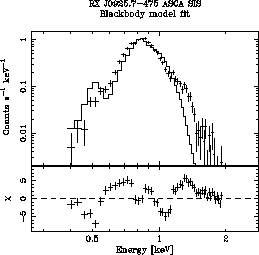ASCA Science Highlights: Super Soft Sources


ASCA SIS spectrum of the SSS (super-soft source) RX J0925.7-475. Left: Blackbody fit result, showing the poor agreements between the data and the model. Right: Best fit blackbody plus edges model. In both, the upper panel shows the data and the best fit model (the latter convolved with the instrument response), while the bottom panel shows the differences in delta chi squared. These plots show that the blackbody model (appropriate for a highly idealized, perfect emitter of light) is inappropriate, and that edges are required to explain the data. The edges are produced in the atmosphere of the white dwarf, in which elements such as oxygen and neon absorb X-ray photons that have specific energies.
This page created by Dr. Koji Mukai (USRA) at the U.S. ASCA Guest Observer Facility.
This file was last modified on Tuesday, 26-Jun-2001 13:16:23 EDT
Curator:
HEASARC Guest Observer Facility
If you have any questions concerning ASCA, visit our Feedback form.

